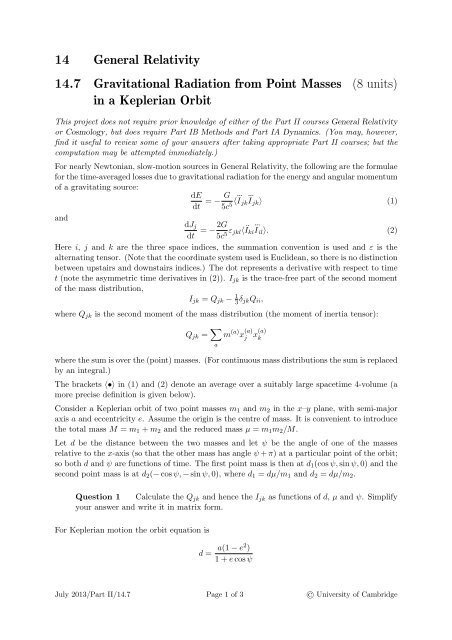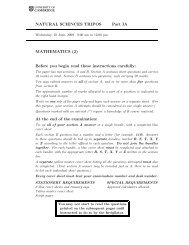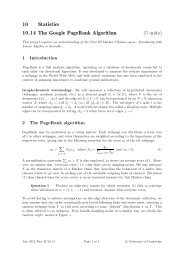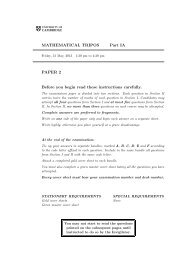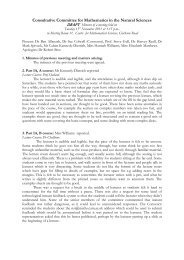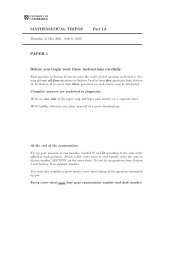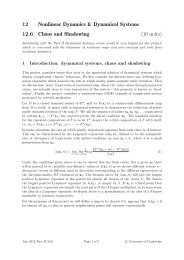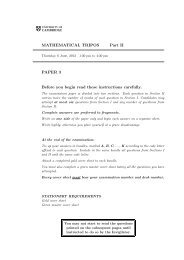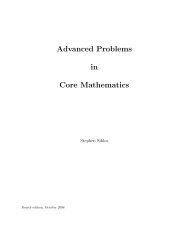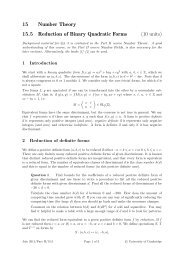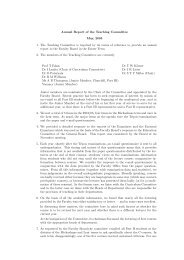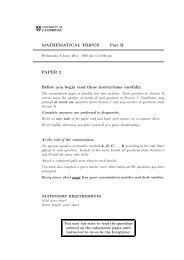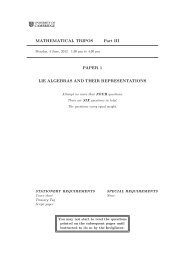14.7 Gravitational Radiation from Point Masses in a Keplerian Orbit
14.7 Gravitational Radiation from Point Masses in a Keplerian Orbit
14.7 Gravitational Radiation from Point Masses in a Keplerian Orbit
- No tags were found...
Create successful ePaper yourself
Turn your PDF publications into a flip-book with our unique Google optimized e-Paper software.
14 General Relativity<strong>14.7</strong> <strong>Gravitational</strong> <strong>Radiation</strong> <strong>from</strong> <strong>Po<strong>in</strong>t</strong> <strong>Masses</strong><strong>in</strong> a <strong>Keplerian</strong> <strong>Orbit</strong>(8 units)This project does not require prior knowledge of either of the Part II courses General Relativityor Cosmology, but does require Part IB Methods and Part IA Dynamics. (You may, however,f<strong>in</strong>d it useful to review some of your answers after tak<strong>in</strong>g appropriate Part II courses; but thecomputation may be attempted immediately.)For nearly Newtonian, slow-motion sources <strong>in</strong> General Relativity, the follow<strong>in</strong>g are the formulaeforthetime-averagedlossesduetogravitationalradiationfortheenergyandangularmomentumof a gravitat<strong>in</strong>g source:dEdt = − G ...5c 5〈... I jk I jk 〉 (1)anddJ jdt = −2G...5c 5ε jkl〈ÏkiI il 〉. (2)Here i, j and k are the three space <strong>in</strong>dices, the summation convention is used and ε is thealternat<strong>in</strong>g tensor. (Note that the coord<strong>in</strong>ate system used is Euclidean, so there is no dist<strong>in</strong>ctionbetween upstairs and downstairs <strong>in</strong>dices.) The dot represents a derivative with respect to timet (note the asymmetric time derivatives <strong>in</strong> (2)). I jk is the trace-free part of the second momentof the mass distribution,I jk = Q jk − 1 3 δ jkQ ii ,where Q jk is the second moment of the mass distribution (the moment of <strong>in</strong>ertia tensor):Q jk = ∑ am (a) x (a)jx (a)kwherethesumisoverthe(po<strong>in</strong>t)masses. (Forcont<strong>in</strong>uousmassdistributionsthesumisreplacedby an <strong>in</strong>tegral.)The brackets 〈•〉 <strong>in</strong> (1) and (2) denote an average over a suitably large spacetime 4-volume (amore precise def<strong>in</strong>ition is given below).Consider a <strong>Keplerian</strong> orbit of two po<strong>in</strong>t masses m 1 and m 2 <strong>in</strong> the x–y plane, with semi-majoraxis a and eccentricity e. Assume the orig<strong>in</strong> is the centre of mass. It is convenient to <strong>in</strong>troducethe total mass M = m 1 +m 2 and the reduced mass µ = m 1 m 2 /M.Let d be the distance between the two masses and let ψ be the angle of one of the massesrelative to the x-axis (so that the other mass has angle ψ+π) at a particular po<strong>in</strong>t of the orbit;so both d and ψ are functions of time. The first po<strong>in</strong>t mass is then at d 1 (cosψ,s<strong>in</strong>ψ,0) and thesecond po<strong>in</strong>t mass is at d 2 (−cosψ,−s<strong>in</strong>ψ,0), where d 1 = dµ/m 1 and d 2 = dµ/m 2 .Question 1 Calculate the Q jk and hence the I jk as functions of d, µ and ψ. Simplifyyour answer and write it <strong>in</strong> matrix form.For <strong>Keplerian</strong> motion the orbit equation isd = a(1−e2 )1+ecosψJuly 2013/Part II/<strong>14.7</strong> Page 1 of 3 ○c University of Cambridge
and the angular velocity is given by√GMa(1−e˙ψ =2 )d 2 .In equations (1) and (2), assume 〈•〉 denotes an average <strong>in</strong> time over one orbit. For a functionw of ψ this means thatwhereis the period of the orbit.〈w〉 = 1 T∫ T0w ( ψ(t) ) dt = 1 TT = 2πa3/2√GM∫ 2π0w(ψ)˙ψ dψAssume that a and e do not change appreciably <strong>in</strong> one orbit, so that their time derivatives canbe ignored <strong>in</strong> the averages.Question 2thatwhereand thatwhereNote that J 1 = J 2 = 0 (i.e., the x and y components of J vanish). Show〈 〉 dE= − 32G4 µ 2 M 3dt 5c 5 a 5 f(e) (3)f(e) =1+7324 e2 + 3796 e4(1−e 2 ) 7/2〈 〉 dJ3= − 32G7/2 µ 2 M 5/2dt 5c 5 a 7/2 g(e) (4)g(e) = 1+ 7 8 e2(1−e 2 ) 2.For <strong>Keplerian</strong> orbits we haveand(J 3 is usually denoted L).E = −G µM2aJ 3 = √ Gµ 2 Ma(1−e 2 )Question 3and thatwhereFor <strong>Keplerian</strong> orbits prove that〈 〉 da= − 64G3 µM 2dt 5c 5 a 3 f(e),〈 〉 de= − 304G3 µM 2dt 15c 5 a 4 h(e)h(e) =(1+121304 e2 )e(1−e 2 ) 5/2 .Under what conditions is it true that the time derivatives of a and e (as just calculated)can be ignored <strong>in</strong> the averages <strong>in</strong> (1) and (2) (as was assumed above <strong>in</strong> deriv<strong>in</strong>g (3) and(4))? (This is a consistency check.)July 2013/Part II/<strong>14.7</strong> Page 2 of 3 ○c University of Cambridge
Question 4F<strong>in</strong>d a as a function of time <strong>in</strong> the case when e ≡ 0 (i.e., a circular orbit).Question 5 The WUMa eclips<strong>in</strong>g b<strong>in</strong>ary star system has m 1 = 0.77M ⊙ and m 2 =0.56M ⊙ (the Sun has mass M ⊙ ≈ 2×10 30 kg), with period T = 0.33days. This determ<strong>in</strong>esthe <strong>in</strong>itial value of a but not of e, so we consider the situation as a function of e.Us<strong>in</strong>g a computer, calculate how much power is be<strong>in</strong>g radiated (now) gravitationally fore = 0, 0.5 and 0.95. Compare the results with the electromagnetic output of the Sun(about 4×10 26 Js −1 ).Write a program to determ<strong>in</strong>e how long it will take, as a function of <strong>in</strong>itial eccentricitye 0 , before a decays to zero for WUMa. Use this program to calculate the decay time for<strong>in</strong>itial values e 0 = 0.00, 0.05, 0.10, ..., 0.95. Compare the results with the present age ofthe universe (13.7×10 9 years).Question 6 Write a program to calculate the <strong>in</strong>itial semi-major axis a 0 that a b<strong>in</strong>arymust have <strong>in</strong> order for the <strong>in</strong>spiral time to be equal to the age of the universe. Use thisto calculate a 0 (<strong>in</strong> units of the solar radius R ⊙ ≈ 7 × 10 8 m) for a b<strong>in</strong>ary consist<strong>in</strong>g ofa solar mass star and giant gas planet of mass 0.001M ⊙ (about a Jupiter mass) withe 0 = 0.00, 0.05, 0.10, ..., 0.95.Hot Jupiters are a class of exoplanets with masses similar to Jupiter, but orbit<strong>in</strong>g at< 0.5AU (where 1AU ≈ 1.5×10 11 m). S<strong>in</strong>ce Jupiter-like planets are expected to form ataround 5AU, us<strong>in</strong>g your above results comment on whether gravitational radiation is apossible mechanism for the Hot Jupiters to have subsequently migrated to their currentlocation.July 2013/Part II/<strong>14.7</strong> Page 3 of 3 ○c University of Cambridge


